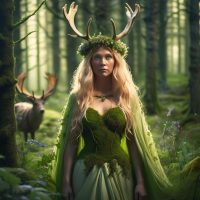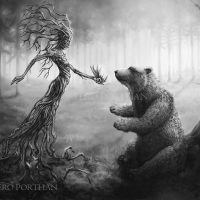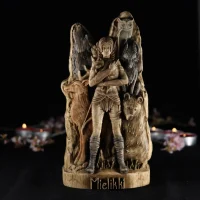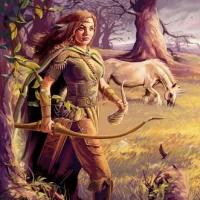Mielikki : The Forest Goddess
Listen
At a glance
| Description | |
|---|---|
| Origin | Finnish Mythology |
| Classification | Gods |
| Family Members | Tapio (Husband), Tuulikki, Tellervo, Nyyrikki, Tyytikki and Annikki (Siblings) |
| Region | Finland |
| Associated With | Forests, Animal Communication, Fertility, Bears |
Mielikki
Introduction
Mielikki is one of the most celebrated deities in Finnish mythology, known as the goddess of the forest, hunting, and healing. She personifies the spirit of the wild, embodying the balance between human life and untamed nature. Unlike many other mythological figures, Mielikki is both a guardian and a nurturer, ensuring that hunters could find game while also caring for wounded animals and restoring harmony in the wilderness. Her role highlights the profound respect that the Finns and other Finno-Ugric peoples held for the forest, which was seen not merely as a resource but as a living, sacred realm. Mentioned in the Kalevala, Finland’s national epic, Mielikki represents the essence of ecological interconnectedness that continues to resonate in Finnish culture today.
Physical Traits
Descriptions of Mielikki emphasize her beauty, which mirrors the richness of the forest itself. She is often imagined as wearing garments adorned with gold and forest motifs, her hair braided with golden ringlets that evoke rays of sunlight shining through dense treetops. A blue cloak, frequently associated with her, symbolizes her protective powers and her dominion over the forest’s mysteries. In some folk tales, she also takes on the guise of a huntress, akin to the Roman goddess Diana, embodying both grace and power. Her presence in the woods was said to inspire calm among animals, suggesting that she carried an aura of serenity that reinforced her role as guardian of all living beings within her domain.
Family
Mielikki is married to Tapio, the Finnish god of the forest, and together they rule as a divine couple over the wilderness. Her children reflect different aspects of the natural world, further expanding her reach as a mother of spirits and minor deities. Tuulikki represents the winds and the guidance of hunters, Tellervo is associated with young animals and maidens of the forest, and Nyyrikki aids hunters in their pursuits. Other figures such as Annikki and Tyytikki carry roles tied to the cycles of forest life and the care of animals. This divine family represents an interconnected system of nature, with Mielikki as its nurturing center, ensuring continuity and balance within the ecosystem.
Other Names
Mielikki is most famously known as “Metsän emäntä,” meaning Mistress of the Forest, a title that emphasizes her sovereignty over the woodland realm. She is also called “Metsän miniä,” or Daughter-in-law of the Forest, reflecting her ties to Tapio and the spirit of the woods. In some regions, particularly in Karelian and Forest Finn traditions, variations of her name and role exist, showing how deeply embedded she was across northern folklore. The name “Mielikki” itself comes from the Finnish word mielu, meaning “luck” or “favor,” perfectly capturing her function as the bestower of fortune to hunters and those who respected the forest’s sacred boundaries.
Powers and Abilities
Mielikki’s powers were central to the survival and prosperity of communities living close to the forest. She was believed to have unmatched knowledge of herbal medicine, capable of healing wounded animals and restoring life to fragile parts of the ecosystem. Hunters invoked her blessings to ensure not only the success of their hunts but also the ethical treatment of animals, reinforcing a spiritual code of respect for nature. In Finnish myths, she is credited with shaping the bear, an animal revered as sacred, giving it claws and teeth as a gift of strength. Her ability to control the forest’s bounty is also significant—she could appear radiant and golden to signal abundance or remain hidden to withhold prey. These powers underline her dual role as a benefactor of those who honored the forest and as a guardian who could withhold its gifts from the careless or disrespectful.
Modern Day Influences
The influence of Mielikki endures in both Finnish culture and global contexts. Within Finland, she remains a symbol of environmental stewardship, often invoked in discussions around sustainability and ecological awareness. References to her appear in folk poetry, art, and storytelling, particularly through the Kalevala, where her presence strengthens the cultural memory of humanity’s bond with the forest. Her legacy extends into science and modern culture as well: a mountain on Venus, Mielikki Mons, bears her name, showing how mythology continues to inspire scientific nomenclature. In contemporary spirituality and fantasy literature, including role-playing games like Dungeons & Dragons, Mielikki has been reimagined as a goddess of rangers and woodland guardians. These modern appearances highlight her timeless relevance, bridging ancient Finnish beliefs with contemporary movements that celebrate nature, healing, and the interconnectedness of all life.
Related Images
Source
Folklore Fun. (2017, November 8). Mielikki Finnish Forest Goddess. Retrieved from https://folklorefun.wordpress.com/2017/11/08/mielikki-finnish-forest-goddess/
AboutMyBrain. (2025, September 1). Mielikki | Meaning & Significance | Goddess Oracle Deck. Retrieved from https://www.aboutmybrain.com/cards/goddesses-of-the-world-oracle-deck/mielikki
Wikipedia contributors. (2003, August 27). Mielikki. Wikipedia. Retrieved from https://en.wikipedia.org/wiki/Mielikki
Finn Myth. (2022, September 7). Mielikki, Finnish Forest Goddess. Retrieved from https://finnmyth.wordpress.com/2022/09/08/mielikki-finnish-forest-goddess/
Amino Apps. (2018, December 19). Mielikki And The Bear – Mythology & Folklore. Retrieved from https://aminoapps.com/c/mythfolklore/page/item/mielikki-and-the-bear/wG0R_e8tpIGzMmJp2L1Kbq70J38b3J2bg
The Demonic Paradise Wiki. Mielikki | The Demonic Paradise Wiki – Fandom. Retrieved from https://the-demonic-paradise.fandom.com/wiki/Mielikki
Wild Lapland Forest. (2025, June 12). Exploring Finnish Mythology: Tales of Gods, Spirits, and Creation. Retrieved from https://wildlaplandforest.com/en/exploring-finnish-mythology-tales-of-gods-spirits-and-creation/
Lore of Ancestors. Mielikki: Goddess of the Forest – Finnish Mythology – Kalevala. Retrieved from https://www.loreofancestors.com/kalevala-finnish-mythology/mielikki/
Krohn, K. (1932). Finnische Mythologie. Helsinki: Suomalainen Tiedeakatemia.
Paulaharju, S. (1934). Suomalaisia taruja ja uskomuksia. Helsinki: WSOY.
Pentikäinen, J. (1999). Kalevala Mythology (2nd ed.). Indiana University Press.
Haavio, M. (1967). Suomalainen mytologia. Helsinki: WSOY.
Siikala, A. L. (2002). Mythic Images and Shamanism: A Perspective on Kalevala Poetry. Finnish Literature Society.
Frequently Asked Questions
What is lorem Ipsum?
I am text block. Click edit button to change this text. Lorem ipsum dolor sit amet, consectetur adipiscing elit. Ut elit tellus, luctus nec ullamcorper mattis, pulvinar dapibus leo.
What is lorem Ipsum?
I am text block. Click edit button to change this text. Lorem ipsum dolor sit amet, consectetur adipiscing elit. Ut elit tellus, luctus nec ullamcorper mattis, pulvinar dapibus leo.
What is lorem Ipsum?
I am text block. Click edit button to change this text. Lorem ipsum dolor sit amet, consectetur adipiscing elit. Ut elit tellus, luctus nec ullamcorper mattis, pulvinar dapibus leo.
What is lorem Ipsum?
I am text block. Click edit button to change this text. Lorem ipsum dolor sit amet, consectetur adipiscing elit. Ut elit tellus, luctus nec ullamcorper mattis, pulvinar dapibus leo.
What is lorem Ipsum?
I am text block. Click edit button to change this text. Lorem ipsum dolor sit amet, consectetur adipiscing elit. Ut elit tellus, luctus nec ullamcorper mattis, pulvinar dapibus leo.









